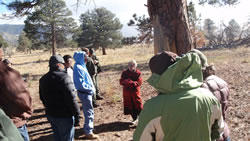National Cohesive Wildland Fire Management Strategy Success Story
Park Receives Cultural Preservation Award
Great Sand Dunes National Park and Preserve, Colorado
Cohesive Strategy - Maintain and Restore Landscapes
2011

Dr. Adrienne Anderson retired NPS Archaeologist talking to tribal members at the scarred trees. Photo by Phyllis Pineda Bovin, NPS.
On Thursday, May 12, 2011, Great Sand Dunes National Park and Preserve was honored by Colorado Preservation Inc, the largest historic preservation organization in Colorado, for the role firefighters played in the protection of "Indian Grove," a group of 72 culturally modified ponderosa pine trees that were at risk during last year’s Medano Fire. The grove is very significant to the history of Native American Nations. The Utes and Apache peoples that have close affiliation to the area; their ancestors extracted key medicinal and nutritional resources from these trees. Tree ring dating has shown that sections of bark were removed from select trees during the 1700, 1800 and the early 1900's. The Indian Grove group of trees is a key cultural resource in the park and is on the National Register of Historic places. This is one of the very few "living" sites on the register.
On June 6, 2010 a lightning strike within Great Sand Dunes National Park started the long-running Medano Fire. This fire ultimately burned for nearly six months in the Sangre de Cristo Wilderness, a steep and remote portion of the National Preserve. Few park facilities were threatened during the fire. Overall the fire burned in a natural mosaic pattern and covered about 6,000 acres.
Previous consultation with tribes including the Utes, Apache and Pueblos proved successful, as the partnerships provided the park resource staff with the direction to protect the trees if possible and not to put firefighters at risk. Both outcomes were realized. Firefighters were instructed to rake duff and other woody material away from bases of the trees in the Indian Grove; hand held drip torches were then used to light the piles, averting the risk for a spot fire to within the tree grouping. As a result, this historically and culturally significant group of 72 trees remains intact and will continue to be an important place for continued tribal visits. These trees are literally one of the only places left from their past that they can touch, see and smell.
The tribes and the park staff realizes that eventually this ancient grove of trees will succumb to time and age; but that day has been postponed for a while.
Contact
Fred Bunch, Chief of Resource Management
Email: Fred_Bunch@nps.gov
Phone: (719) 378-6361
Keywords: Native American Nations, Partnerships